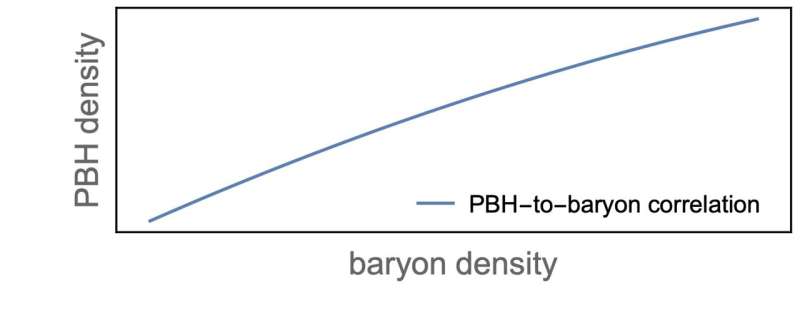February 14, 2022 feature
Theory shows baryogenesis requirement could drive the contribution of primordial black holes to dark matter

While many studies have hinted at the existence of dark matter, a material that does not absorb, reflect or emit light, this elusive substance has not been directly observed so far. Over the past few decades, many teams worldwide have thus theorized about its possible properties and composition in the hope to identify possible strategies for detecting it in the universe.
Primordial black holes (PBHs), black holes that theoretical physicists believed formed soon after the Big Bang, have been promising dark matter candidates since 2016. That year, the LIGO Collaboration first detected an event in the gravitational waves resulting from a binary black hole merger.
Studies suggest that the total amount of dark matter in the universe today is approximately five times larger than that of ordinary matter, also referred to as baryons. The reasons for this significantly higher proportion of dark matter, however, remain unclear. This unanswered research question is known as the cosmic coincidence problem.
Yi-Peng Wu, Elena Pinetti and Joseph Silk, three researchers at Laboratoire de Physique Théorique et Hautes Energies (LPTHE), UMR 7589 CNRS and Sorbonne Université, the Fermi National Accelerator Laboratory, and Institut d'Astrophysique de Paris (IAP, UMR 7095 CNRS), have recently carried out a study aimed at providing a possible solution to the cosmic coincidence problem. In their paper, published in Physical Review Letters, they suggest that the higher proportion of dark matter could be linked to baryogenesis, a physical process leading to baryonic asymmetry that is hypothesized to have occurred in the early universe.
"Our recent paper in Physical Review Letters came out when we were trying to propose a possible explanation to the cosmic coincidence problem for considering PBH as DM, which is also the main objective of the research," Yi-Peng Wu, one of the researchers who carried out the study, told Phys.org. "The letter is mainly based on one of our previous works, "Baryogenesis from ultra-slow-roll inflation," in which successful baryogenesis (to account for the observed baryon asymmetry in our universe today) was verified at length in the representative scenario (which is dubbed the ultra-slow-roll inflation) for PBH formation."
The theory of ultra-slow-roll inflation suggests that in its early days, the universe expanded at an unusual rate. This unusual expansion rate could have significantly enhanced density perturbations, promoting the formation of primordial black holes.
"We argue that such an unusual cosmic expansion (during the transient ultra-slow-roll phase) can also trigger the evolution of the 'source field' that eventually creates a net baryon asymmetry for the universe," Wu said. "The source field is usually some scalar particles charged with baryon numbers. As a result, the appearance of the ultra-slow-roll phase becomes the mutual origin for baryons and PBHs so that their densities today exhibit some correlations."
Past astrophysics studies have highlighted the baryon asymmetry of the universe. In other words, they showed that the universe does not contain ordinary antimatter. This is because this ordinary antimatter annihilated with an equal amount of matter in the universe's early days.
"The leftover matter formed stars and galaxies," Wu explained. "Protons and neutrons, collectively called baryons, and the net baryon number quantifies the excess of ordinary matter (baryons) over antimatter (antibaryons)."
In their recent paper, Wu and his colleagues introduced the first theory clearly computing the correlation function between baryon and dark matter densities associated with primordial black holes. In the future, their theory could inspire the development of new experimental procedures and designs that could be used to search for dark matter in the universe.
"The baryon-to-DM density correlation specifies a limited parameter space for explaining the cosmic coincidence so that the validity of the theory can be tested by future experiments," Wu added. "In fact, we are now working on the observational consequences of the theory in the cosmic gravitational-wave background. The gravitational-wave background of the universe is currently being tested by LIGO and Virgo, and will also be probed by future space-based telescopes such as LISA, Einstein Telescope and DECIGO."
More information: Yi-Peng Wu et al, Cosmic Coincidences of Primordial-Black-Hole Dark Matter, Physical Review Letters (2022). DOI: 10.1103/PhysRevLett.128.031102
Journal information: Physical Review Letters
© 2022 Science X Network




















